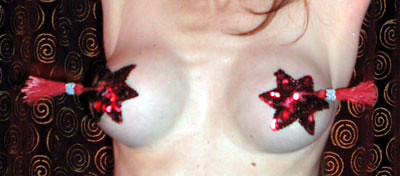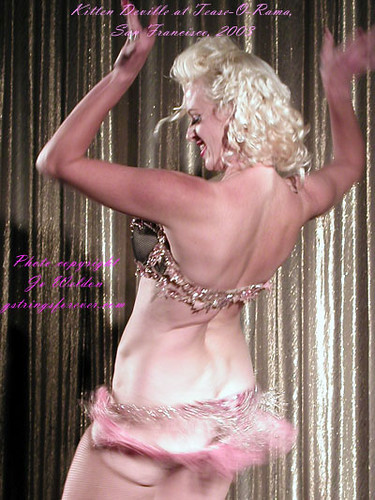A Brief Burlesque Glossary
This was originally intended for The Burlesque Handbook. It was originally five times longer. I kept editing and editing and it was still too long, and ultimately even this version didn't make it in. I had forgotten all about it! I've written more burlesque glossaries, some based on vintage terminology, one very technical, and one illustrated and really mean and filthy! I'm illustrating with some old photos just because I haven't seen them myself for awhile.

Attribution: Giving specific and upfront credit for the source of inspiration or influence. Contrary to maxim, this is the highest form of flattery.
Backstage: Behind the stage or in the dressing area, usually out of sight of the audience.
Bump ‘n’ grind: A bump is a snap of the hips, and a grind is a circular motion of the hips.
Burlesque: A style of performance featuring low-brow humour and high-brow strippers. Brittanica says: "In burlesque the serious is treated lightly and the frivolous seriously.”
Burlesque Routine (Number, Act, Piece, etc): For the purpose of this book, by "burlesque routine," we mean a 3-5 minute live performance piece, often including pantomime or physical acting, that includes stripping.
Choreography: A repeatable series of movements, usually dance-based and performed and timed to specific music. Subject to copyright.

Costume: Among other things, a costume is an outfit constructed or adapted for the purpose of theatrical performance. A lingerie set is not a costume, but if decorated and made breakaway, it can become a costume.
Drag: Clothing, hair, makeup, and/or costuming which transforms, questions, and/or exaggerates gender. Usually male to female, but can be female to male, female to female, male to male, or androgynous. Can also refer to being in costume or stage makeup, but usually connotes gender drag.
G-String: A triangle of fabric that covers the pubic area, held on by the most minimal of strings or bands. Most often a g-string is legally required, though some performers choose to make their privates public in certain venues.
Merkin or Mirkin: A piece of fabric, or anything else glued over the pubis to conceal the bits. Basically, a g-string without the string.
Opening: In a number, the beginning of a performance. An opening should be planned in keeping with the maxim, “You never get a second chance to make a first impression." The closing of a number should be a bang, not a whimper.

Pastie: Anything glued over the nipple (although they can also be stuck to other parts of the body, such as the derriere). They are usually circular but can be any shape, and are usually made out of fabric but can be made out of anything, including cheese. Often tassels are sewn to the tip of the pasties, and performers twirl them by bouncing or shimmying.
Peel: To remove a garment in a slow and/or dramatic manner, revealing flesh inch by inch.
Reveal (Noun): A moment in a burlesque number during which the performer shows something to the audience which was not previously seen, often a body part but often even more effectively a costume part, a prop, or a characteristic of the performance. A “Big Reveal” is the climactic, most memorable event in a number—it may be something as common as a pastie or as unusual as the performer bringing a white tiger onstage.
Safety Pins: Often used in place of sewing or glue. Should be in every burlesque performer’s bag for quick fixes to the stress and strain constant stripping puts on garments, as well as to share in order to make friends.

Shimmy: A prolonged shaking of the hips or shoulders, which is greatly accentuated if a performer’s costume is fringed.
Showgirl: An elaborately costumed performer, usually in a headdress, who may or may not strip.
Stage Litter: What burlesque strippers leave behind after performing, preferably only removed clothing (which a performer should place or fling away from him or herself and should NOT have to dance upon or around). Generally, water, food, confetti, wax, fake blood, etc. on the floor makes it hard on the act that follows, so an experienced performer usually leaves behind only clothes and a remembrance of charisma.

Swarovski: Particularly high quality crystal used for garment embellishment, jewelry, and home decoration. Known to inspire acquisitive and obsessive behavior.
Tagline: A brief memorable description of a performer that follows his or her name, like “The Girl with the Twirl.”
Tassels: Narrow bits of fringe that are usually affixed to pasties for the purpose of twirling; also, tasseled pasties are often referred to simply as tassels. “Assels” are tasseled pasties on the derriere.
Upstage: Toward the back of the stage, hence downstage is toward the audience. "Upstage" is also a term used to describe the act of deliberately taking over the space of another performer, generally to the detriment of the cohesiveness of the show as a whole.
Zeitgeist: Something that reflects the spirit of an era. Burlesque in the 21st century reflects its own time and place and has a zeitgeist of its own!
Feel free to quote and use as you like, as long as you attribute it to schoolofburlesque.com.

Attribution: Giving specific and upfront credit for the source of inspiration or influence. Contrary to maxim, this is the highest form of flattery.
Backstage: Behind the stage or in the dressing area, usually out of sight of the audience.
Bump ‘n’ grind: A bump is a snap of the hips, and a grind is a circular motion of the hips.
Burlesque: A style of performance featuring low-brow humour and high-brow strippers. Brittanica says: "In burlesque the serious is treated lightly and the frivolous seriously.”
Burlesque Routine (Number, Act, Piece, etc): For the purpose of this book, by "burlesque routine," we mean a 3-5 minute live performance piece, often including pantomime or physical acting, that includes stripping.
Choreography: A repeatable series of movements, usually dance-based and performed and timed to specific music. Subject to copyright.

Costume: Among other things, a costume is an outfit constructed or adapted for the purpose of theatrical performance. A lingerie set is not a costume, but if decorated and made breakaway, it can become a costume.
Drag: Clothing, hair, makeup, and/or costuming which transforms, questions, and/or exaggerates gender. Usually male to female, but can be female to male, female to female, male to male, or androgynous. Can also refer to being in costume or stage makeup, but usually connotes gender drag.
G-String: A triangle of fabric that covers the pubic area, held on by the most minimal of strings or bands. Most often a g-string is legally required, though some performers choose to make their privates public in certain venues.
Merkin or Mirkin: A piece of fabric, or anything else glued over the pubis to conceal the bits. Basically, a g-string without the string.
Opening: In a number, the beginning of a performance. An opening should be planned in keeping with the maxim, “You never get a second chance to make a first impression." The closing of a number should be a bang, not a whimper.

Pastie: Anything glued over the nipple (although they can also be stuck to other parts of the body, such as the derriere). They are usually circular but can be any shape, and are usually made out of fabric but can be made out of anything, including cheese. Often tassels are sewn to the tip of the pasties, and performers twirl them by bouncing or shimmying.
Peel: To remove a garment in a slow and/or dramatic manner, revealing flesh inch by inch.
Reveal (Noun): A moment in a burlesque number during which the performer shows something to the audience which was not previously seen, often a body part but often even more effectively a costume part, a prop, or a characteristic of the performance. A “Big Reveal” is the climactic, most memorable event in a number—it may be something as common as a pastie or as unusual as the performer bringing a white tiger onstage.
Safety Pins: Often used in place of sewing or glue. Should be in every burlesque performer’s bag for quick fixes to the stress and strain constant stripping puts on garments, as well as to share in order to make friends.

Shimmy: A prolonged shaking of the hips or shoulders, which is greatly accentuated if a performer’s costume is fringed.
Showgirl: An elaborately costumed performer, usually in a headdress, who may or may not strip.
Stage Litter: What burlesque strippers leave behind after performing, preferably only removed clothing (which a performer should place or fling away from him or herself and should NOT have to dance upon or around). Generally, water, food, confetti, wax, fake blood, etc. on the floor makes it hard on the act that follows, so an experienced performer usually leaves behind only clothes and a remembrance of charisma.

Swarovski: Particularly high quality crystal used for garment embellishment, jewelry, and home decoration. Known to inspire acquisitive and obsessive behavior.
Tagline: A brief memorable description of a performer that follows his or her name, like “The Girl with the Twirl.”
Tassels: Narrow bits of fringe that are usually affixed to pasties for the purpose of twirling; also, tasseled pasties are often referred to simply as tassels. “Assels” are tasseled pasties on the derriere.
Upstage: Toward the back of the stage, hence downstage is toward the audience. "Upstage" is also a term used to describe the act of deliberately taking over the space of another performer, generally to the detriment of the cohesiveness of the show as a whole.
Zeitgeist: Something that reflects the spirit of an era. Burlesque in the 21st century reflects its own time and place and has a zeitgeist of its own!
Feel free to quote and use as you like, as long as you attribute it to schoolofburlesque.com.

Comments
Being on the photography side of things and looking for more opportunities to photograph performers and artists I'll be back to update my knowledge and learn more from your blog.
All the best!
Thank you for all your hard work.
Amor y paz,
Santos de Los Angeles